
Animal motif on the forehead
 11. 05. 2024
11. 05. 2024




 11. 05. 2024
11. 05. 2024
 7
7

 1
1

 09. 05. 2024
09. 05. 2024

 08. 05. 2024
08. 05. 2024
 28. 02. 2024
28. 02. 2024

Mohamed Ibrahim: When Auguste Mariette rediscovered the Serapeum in Saqqara in 1850, he found more than 25 granite boxes, with only one still closed. The others were open and empty. According to Auguste Mariette, the mummy of a bull worshiped as the god Apis was in the only closed box. This mummy is to be stored in the Agricultural Museum. But when you come to this museum, you will find several skeletons of bulls, but no mummies. It is therefore a mystification on the part of Auguste Mariette, as his alleged discovery is used as an argument that the place served as the burial place of the sacred bull Apis.
Although the Egyptians did manage to mummify animals (and did so abundantly), then there is not a single mummified be associated with this place today called Serapeum. It should be noted that the average internal size of each box is 4 times larger than any bull.
Sueneé: Enrich von Däniken states that Mariette actually found himself in boxing bitumen. Bitumen is a form of asphalt which, in this case, contained bone fragments from various animals. The finding itself does not fit into the concept of mummification of anything. Something else must have happened here. Unfortunately, samples are not (at least officially) available to say more.
Yousef Awyan: The Serapea complex is much larger than it is today. There are other corridors, but nobody has yet revealed them.
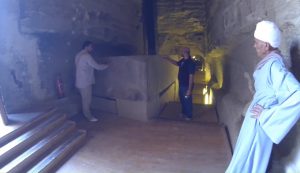 Sueneé: This is the lid of one of the boxes. It is located right at the entrance to the underground complex. The stated weight is more than 30 tons.
Sueneé: This is the lid of one of the boxes. It is located right at the entrance to the underground complex. The stated weight is more than 30 tons.
Yousef: The boxes are made of one piece of stone. How did they manage to place it here and still sink it into the ground? Realize that there is really little room for manipulation.
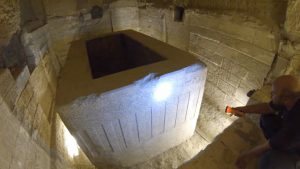 Mohamed commented on the boxing inscription: I will give you your name Igor (the name of the cameraman) and the name of God Ra into the cartridge. If I read it I would say: "Igor meri Ra" Igor loving Ra. I have said Igor first name, but when I write it, I will first write a name Ra with respect for the fact that he is a god. So it would be in the cartouche Ra as the first one.
Mohamed commented on the boxing inscription: I will give you your name Igor (the name of the cameraman) and the name of God Ra into the cartridge. If I read it I would say: "Igor meri Ra" Igor loving Ra. I have said Igor first name, but when I write it, I will first write a name Ra with respect for the fact that he is a god. So it would be in the cartouche Ra as the first one.
It's written similarly on the box. It is written in the cartouche Osiris a Habi. The name should be correct Osiris (name of god) first, but in the cartouche we see mentioned first Habi.
Sueneé: Mohamed points out that this is very unusual and leads to the idea that it is grammatically a mistake. Yousef admits that the inscription apparently originated at a much younger time than the box itself.
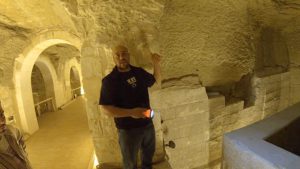 Yousef: These wall coverings are probably not original. They were formed later. When we get behind that door (where tourists can't get), we'll see that they used ancient stones (from other buildings) to reconstruct this area.
Yousef: These wall coverings are probably not original. They were formed later. When we get behind that door (where tourists can't get), we'll see that they used ancient stones (from other buildings) to reconstruct this area.
Yousef: Generations before us used this space in different ways and improved it to their own needs. We now use it for sightseeing. We reconstructed it according to our ideas and introduced wires and electricity here. This place could have been used in various ways over the millennia. Even as a symbolic burial ground for bulls. But that says nothing about the original purpose of the building. It happened under the Greeks and Romans. This had happened long before the dynastic Egyptians. Everyone added something or took away something - they used the place as a quarry.
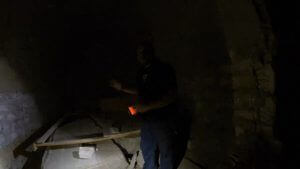 Yousef: This broken monoblock of a fake door. On both sides of the boxes there are niches in which these false doors were placed.
Yousef: This broken monoblock of a fake door. On both sides of the boxes there are niches in which these false doors were placed.
Sueneé: The so-called fake doors are either a symbolic reference to a technological device, or it is just the device itself that just misses the keys and connection.
Igor: So it looks like the boxes were definitely more.
Yousef: Yes, they smashed them into smaller pieces and used elsewhere.
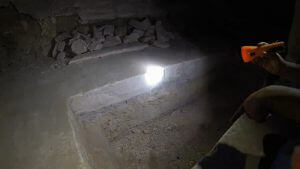 Yousef: Here you see that they took stones from another building and used them in the reconstruction. How do we know? Look at these inscriptions. You shouldn't be here. They don't make sense here.
Yousef: Here you see that they took stones from another building and used them in the reconstruction. How do we know? Look at these inscriptions. You shouldn't be here. They don't make sense here.
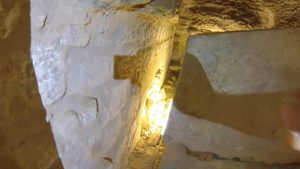 Igor: who would want to work in such a cramped space.
Igor: who would want to work in such a cramped space.
Sueneé: There is really so little space that one can hardly stretch here. Nevertheless, someone somehow placed a box here with a lid weighing more than 100 tons. And that is the weight of the box after its processing. The weight of the block of stone itself must have been much greater. Chris Dunn states that the final processing of the boxes was probably done after their placement. This is explained by the fact that any change in external conditions (atmospheric pressure, ambient humidity, temperature) affects the final product - in this case diorite box.
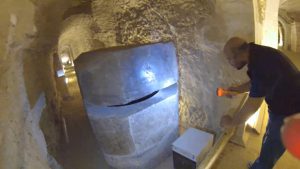 Yousef: The corridor behind the box leads to the left. There's a room. It looks like they decided to pull the box out, but for some reason it didn't happen. He stopped here.
Yousef: The corridor behind the box leads to the left. There's a room. It looks like they decided to pull the box out, but for some reason it didn't happen. He stopped here.
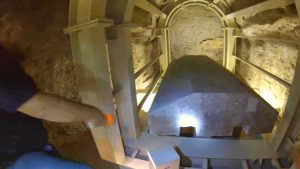 Yousef: There must have been some other material in the niches in the lid. Maybe two pieces of an alloy of gold and silver, or gold itself.
Yousef: There must have been some other material in the niches in the lid. Maybe two pieces of an alloy of gold and silver, or gold itself.
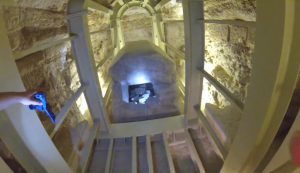 Yousef: this is the only one who tried to open them with explosives. Thanks to that we can look at it comfortably.
Yousef: this is the only one who tried to open them with explosives. Thanks to that we can look at it comfortably.
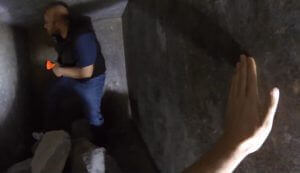 Yousef: Note that the surface inside is much more perfect (smooth and flat) than on the outside. It wouldn't make sense to do something like that for bull mummies. Why would they put so much work into it? It's bullshit!
Yousef: Note that the surface inside is much more perfect (smooth and flat) than on the outside. It wouldn't make sense to do something like that for bull mummies. Why would they put so much work into it? It's bullshit!
Sueneé: The box is made of black granite.
Igor: I saw a documentary in which Graham Hancock was in this box.
Yousef: Yes, Chris Dunn too. Chris Dunn was the first to be allowed to carry out the measurements here.
Sueneé: Yousef sings a deep OM. The whole space resonates strongly. It is obvious that it was purposefully acoustically tuned. This is not an isolated case in Egypt.
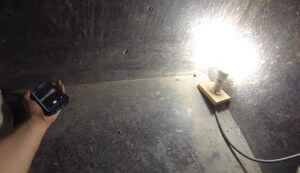 Sueneé: with modern technology it is not possible to create such sharp corners that we find in the boxes in Serapeu. Are we hitting our technological limits here, as our ancestors did? From the point of view of modern technology, we can take circular saws and cut straight walls, and how do you make a corner like that (where a light bulb stands)? The first option is to take a drill, but again you will find that the drill has its radius and you can only use it from above. Chopping black granite by hand is a utopia. Chris Dunn states that the flatness of the surfaces corresponds to the standards that serve as the basis for the calibration of gauges today (last 20 years). This cannot be achieved by mechanical rough grinding.
Sueneé: with modern technology it is not possible to create such sharp corners that we find in the boxes in Serapeu. Are we hitting our technological limits here, as our ancestors did? From the point of view of modern technology, we can take circular saws and cut straight walls, and how do you make a corner like that (where a light bulb stands)? The first option is to take a drill, but again you will find that the drill has its radius and you can only use it from above. Chopping black granite by hand is a utopia. Chris Dunn states that the flatness of the surfaces corresponds to the standards that serve as the basis for the calibration of gauges today (last 20 years). This cannot be achieved by mechanical rough grinding.
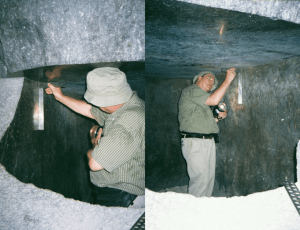 Yousef: The biggest problem is right angles.
Yousef: The biggest problem is right angles.
Sueneé: Chris Dunn shows that his very precise charcoal on the wall does not transmit light. This means that the surfaces are at right angles and there are no irregularities.
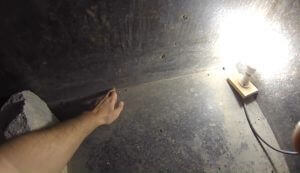 Igor: You can not insert a sheet of paper there.
Igor: You can not insert a sheet of paper there.
Yousef: Surely it's one piece.
Mohamed: The whole box including the lid was originally one piece of stone. It was all processed by some machine technology.
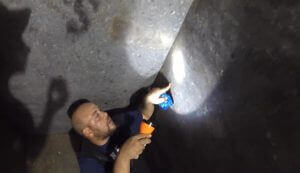 Yousef: You can see it's the same kind of stone. Probably the same block of stone.
Yousef: You can see it's the same kind of stone. Probably the same block of stone.
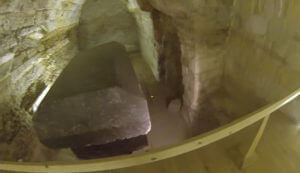 Igor: Here it is easy to see that on the sides there was some equipment in the wall in the niches which was removed.
Igor: Here it is easy to see that on the sides there was some equipment in the wall in the niches which was removed.
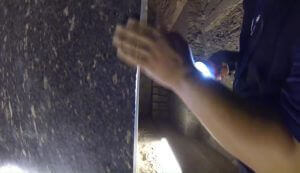 Yousef: Look at this as sharp as the edge. If you pressed your shots, it's still sharp after years! The surface is wonderfully smooth.
Yousef: Look at this as sharp as the edge. If you pressed your shots, it's still sharp after years! The surface is wonderfully smooth.
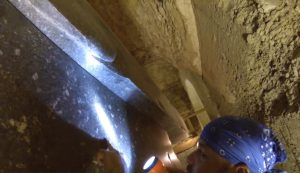 Yousef: Do you see this? That's how they polished the surface. It had to be some liquid that had been used on the surface to soften it and exterminate it. No grinding. Here's how the liquid has stuck to the gap between the lid and the box itself. It can be seen in many places. At first glance, it looks as if it's still liquid, but it's not.
Yousef: Do you see this? That's how they polished the surface. It had to be some liquid that had been used on the surface to soften it and exterminate it. No grinding. Here's how the liquid has stuck to the gap between the lid and the box itself. It can be seen in many places. At first glance, it looks as if it's still liquid, but it's not.
Igor: When I try to do it, it is so strange - different. As if I still felt the residue of that substance.
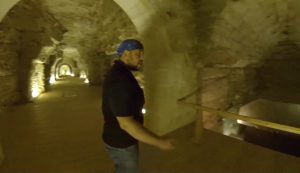 Yousef: Look at the long corridor they dug out here. How did they shine here? We brought the electricity here. Some say they are lit by torches or oil lamps. But there would be traces of smoke on the ceiling. It's not here. There are also theories that they used oil that does not smoke. Even if it was true, imagine it. You have, for example, 4 workers who kick the tunnel. After a while, there is so much dust and so little oxygen to suffocate. Dust blocks already light light.
Yousef: Look at the long corridor they dug out here. How did they shine here? We brought the electricity here. Some say they are lit by torches or oil lamps. But there would be traces of smoke on the ceiling. It's not here. There are also theories that they used oil that does not smoke. Even if it was true, imagine it. You have, for example, 4 workers who kick the tunnel. After a while, there is so much dust and so little oxygen to suffocate. Dust blocks already light light.
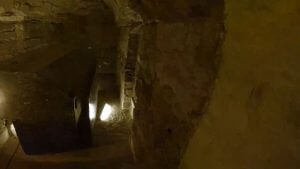 Yousef: See how light is reflected in the polished surface of a granite tub. It does not stand out on the lid because it is covered in dust. If there was no dust, it would shine anyway.
Yousef: See how light is reflected in the polished surface of a granite tub. It does not stand out on the lid because it is covered in dust. If there was no dust, it would shine anyway.
Mohamed: Notice the clean straight cut on the lid.
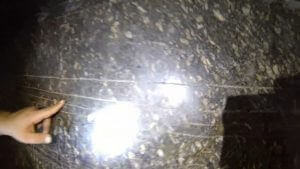 Yousef: This one is one of the few that they made steps to, because there are inscriptions on it. You can clearly see that it's scratched out here. The lines are not straight at all. It is sold and qualitatively incommensurable compared to the bathtub itself. I am convinced that the inscriptions were added later at a much younger time.
Yousef: This one is one of the few that they made steps to, because there are inscriptions on it. You can clearly see that it's scratched out here. The lines are not straight at all. It is sold and qualitatively incommensurable compared to the bathtub itself. I am convinced that the inscriptions were added later at a much younger time.
Sueneé: Personally, it feels like today's vandal claw keys into windows or lifts.
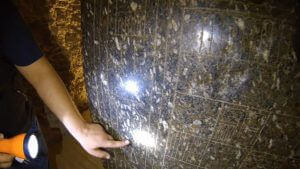 Yousef: You can see here that there is a cartouche where the sovereign's name should be, and it is empty. It is obvious that a priest has prepared the text and then sought a buyer who would be willing to pay for his name placed here. If Igor came here, and I had his name written, all Egyptologists would say that the sarcophagus came into being during the reign of Igor (cameraman).
Yousef: You can see here that there is a cartouche where the sovereign's name should be, and it is empty. It is obvious that a priest has prepared the text and then sought a buyer who would be willing to pay for his name placed here. If Igor came here, and I had his name written, all Egyptologists would say that the sarcophagus came into being during the reign of Igor (cameraman).
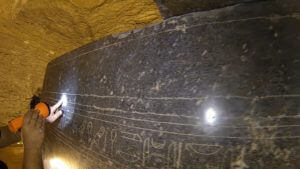 Yousef: The one who wrote it did not have the good tools to keep a straight line on a smooth surface. You can see how crooked it is. Here he even jumped a chisel and the line is interrupted. You don't have to be a great text reading professional to understand that this was added much later. We try to understand the meaning of those boxes based on the texts we see here. As you can see, it is obvious that they were added much later.
Yousef: The one who wrote it did not have the good tools to keep a straight line on a smooth surface. You can see how crooked it is. Here he even jumped a chisel and the line is interrupted. You don't have to be a great text reading professional to understand that this was added much later. We try to understand the meaning of those boxes based on the texts we see here. As you can see, it is obvious that they were added much later.
Mohamed: Unlike yousef, I think these inscriptions are very modern (modern).
Yousef: So 3000 let back or something? I estimate this for the period of Greece or Rome.
Mohamed: No no. Much younger, something like the present. (Immediately, she gets married to Mariette. Cheaters in the history of archeology)
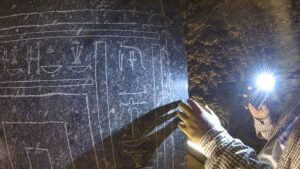 Sueneé: As Muhammad comments, the one who wrote it was clearly not a professional. The symbols are unequally large with incorrect shape proportions. It's about the same as if I swapped "r" and "z" in written form, or confused uppercase and lowercase letters. I have personally checked the texts on the temple walls several times within one continuous text, they are always the same proportionally and in shape - it's like from a printer.
Sueneé: As Muhammad comments, the one who wrote it was clearly not a professional. The symbols are unequally large with incorrect shape proportions. It's about the same as if I swapped "r" and "z" in written form, or confused uppercase and lowercase letters. I have personally checked the texts on the temple walls several times within one continuous text, they are always the same proportionally and in shape - it's like from a printer.
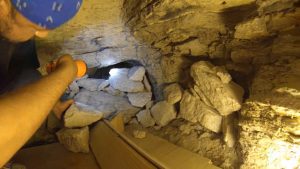 Yousef: There's a lot more. There are many more corridors and facilities. They know it, but they do not want to deal with it.
Yousef: There's a lot more. There are many more corridors and facilities. They know it, but they do not want to deal with it.